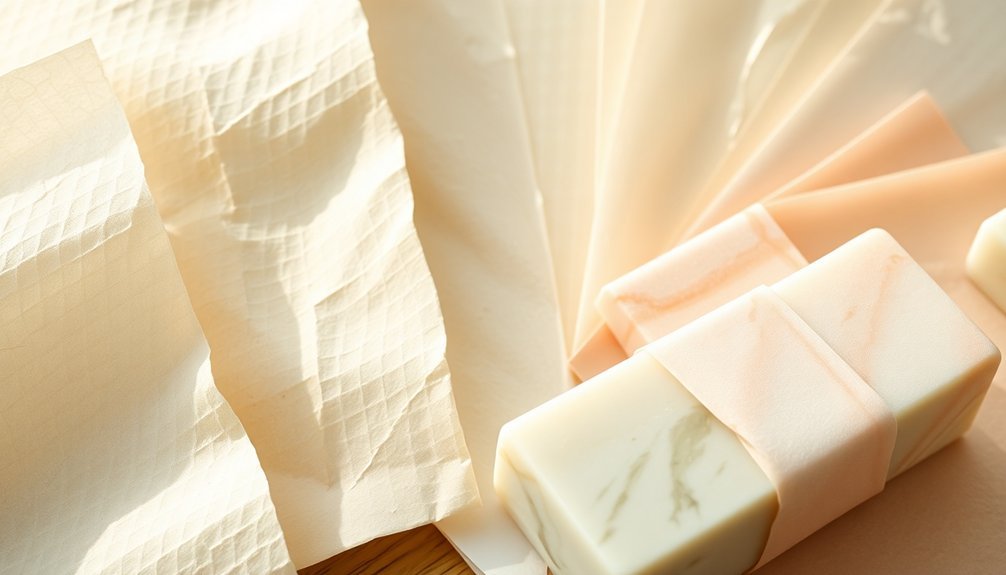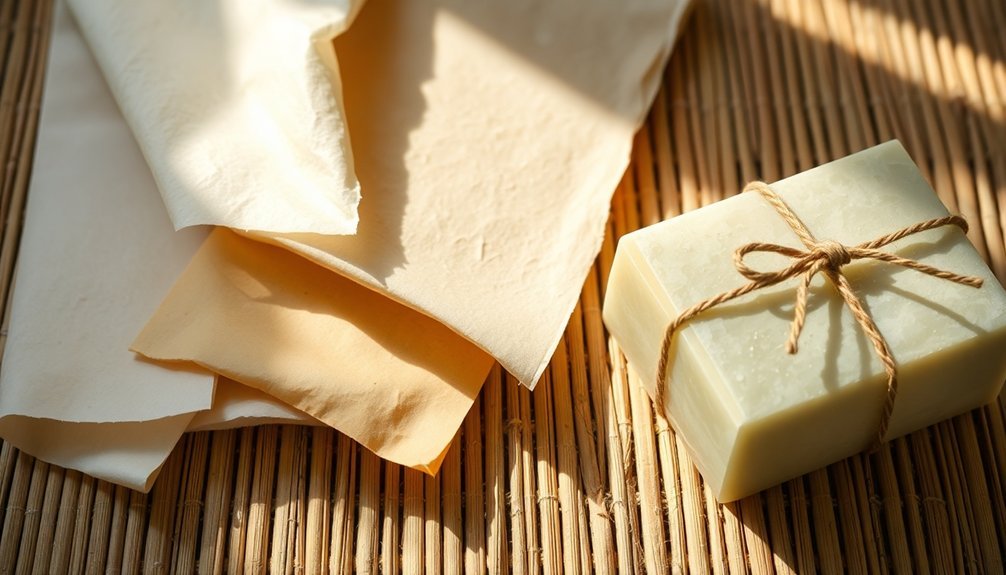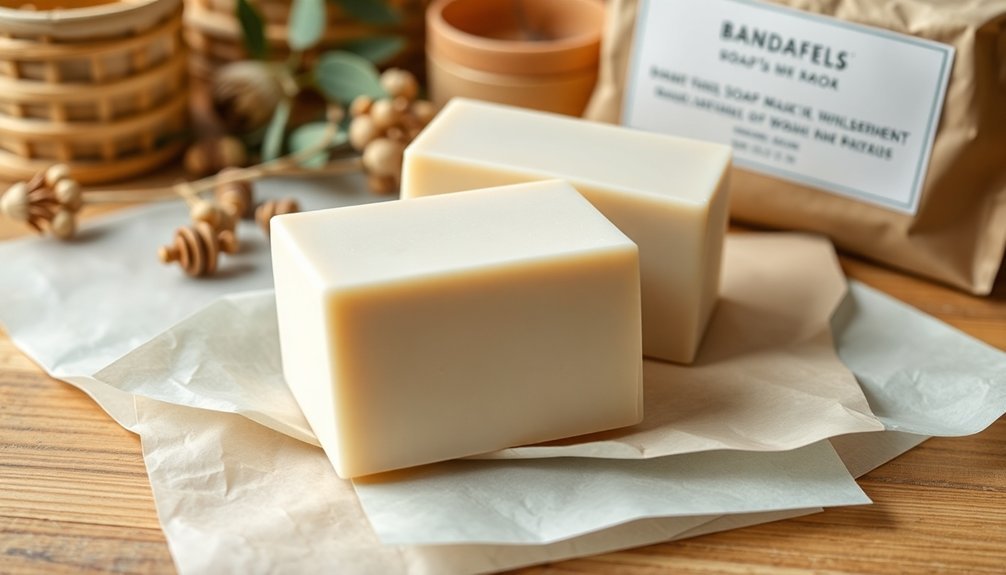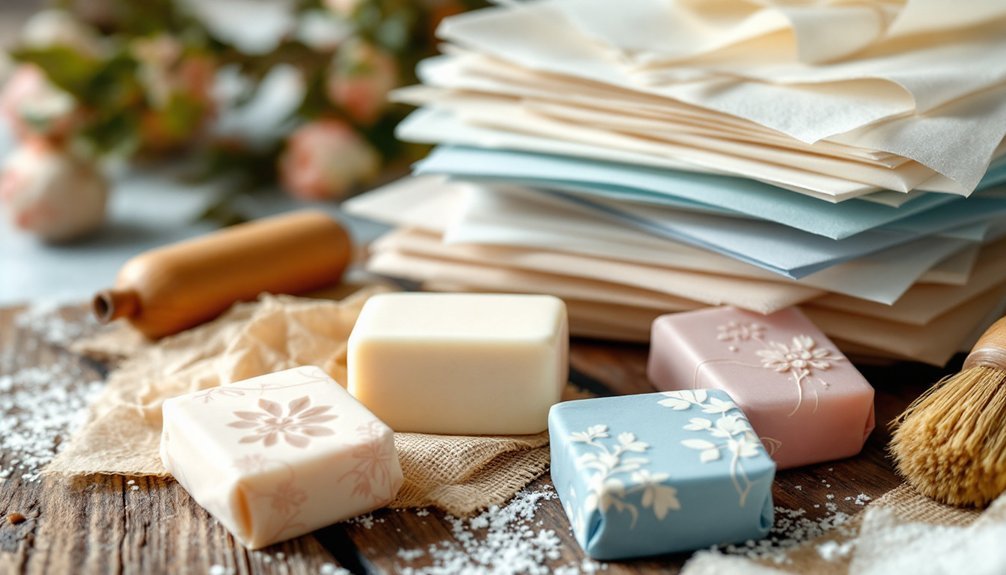Japanese washi paper is a biodegradable, moisture-resistant handmade paper perfect for soap packaging. Made from plant fibers like kozo, mitsumata, and gampi, it offers both durability and aesthetic appeal for your handmade soaps. You'll find it creates distinctive textures while maintaining eco-friendliness. It's recognized by UNESCO as an Intangible Cultural Heritage and comes in various types like kozogami for strength and ganpishi for luxury presentation. Discover how this centuries-old tradition can transform your soap presentation.
The Origins and Heritage of Japanese Washi Paper

While many crafting materials come and go with passing trends, Japanese washi paper has maintained its revered status for over fourteen centuries. Its origins trace back to approximately 610 CE when Buddhist monks introduced paper-making techniques from China to Japan.
The term "washi" literally means "Japanese paper," combining "wa" (Japanese) and "shi" (paper), underscoring its deep roots in Japanese culture.
What sets traditional washi apart is its composition—crafted from plant fibers like kozo, mitsumata, and gampi, making it remarkably strong and durable.
Initially reserved for sacred texts and official documents, washi has evolved into a versatile medium for various art forms. Its cultural significance earned it recognition as a UNESCO Intangible Cultural Heritage.
Unique Characteristics of Washi Paper for Soap Packaging
Washi paper's distinctive texture adds elegant visual appeal to your soap products, immediately setting your brand apart from competitors.
You'll find this Japanese paper offers outstanding sustainability credentials with its biodegradable composition and minimal environmental footprint during production.
Its natural moisture-resistant properties protect your soaps while allowing them to breathe, preventing condensation issues that plague conventional packaging materials.
Texture Enhances Brand Appeal
Texture becomes the silent ambassador of your soap brand when you choose Japanese washi paper for packaging. The distinctive fibers from kozo and gampi plants create a tactile experience that immediately communicates artisanal quality to customers.
This traditional Japanese paper transforms ordinary products into premium offerings that stand out on crowded shelves. You'll benefit from washi paper's natural variation and depth, which provides sophisticated visual appeal while remaining durable enough to protect your soaps.
The paper's translucent qualities create an intriguing peek at what's inside, heightening customer curiosity. Plus, customizable washi paper allows you to incorporate your unique branding elements and artistic vision.
With consumers increasingly valuing sustainable packaging, washi's eco-friendly composition strengthens your brand's environmental credentials while delivering the aesthetic excellence that elevates your soap line above competitors.
Sustainable Packaging Excellence
Japanese artisans have perfected a packaging solution that meets modern sustainability demands without sacrificing functionality. When you choose washi for your soap packaging, you're embracing a truly biodegradable material crafted from kozo, gampi, and mitsumata fibers that return naturally to the earth.
Washi's remarkable strength-to-weight ratio makes it an exceptional sustainable packaging option. You'll reduce your carbon footprint as the lightweight paper minimizes shipping weights while still providing superior protection.
Despite its delicate appearance, washi stands up admirably to moisture—a vital feature for soap products.
What sets washi apart is how it achieves sustainability without compromising aesthetics. The natural inclusions like flower petals or bark fragments create distinctive packaging that communicates your brand's commitment to both environmental responsibility and artisanal quality.
Moisture-Resistant Design Features
Unlike conventional paper that quickly deteriorates when exposed to moisture, traditional washi boasts remarkable water-resistant properties that make it ideal for soap packaging. The natural kozo and gampi fibers create a moisture-resistant barrier that protects your soaps from humidity while maintaining the paper's structural integrity.
You'll appreciate how washi's unique texture adheres perfectly when folded and sealed, keeping your products fresh during storage and shipping. The paper wraps snugly without tearing, thanks to its lightweight yet surprisingly durable composition.
Beyond its practical benefits, washi offers eco-friendly packaging that doesn't compromise on protection. Its moisture-resistant qualities work alongside its ability to showcase vibrant designs, giving your soaps professional presentation while ensuring they remain pristine until they reach your customers' hands.
Types of Washi Paper Best Suited for Soap Making
Artisans seeking the perfect wrapping for their handcrafted soaps will find several distinctive washi paper varieties particularly well-suited to soap making applications.
Kozogami's mulberry fiber composition offers exceptional strength and durability, making it ideal for wrapping and labeling your creations.
Mitsumata paper resists creasing and provides a unique texture that enhances your soap's visual appeal through decorative packaging or inserts.
For premium presentations, Ganpishi's glossy finish and aging resistance elevate high-end artisan soaps to luxury status.
- Strength and durability – critical for handling and packaging
- Texture variation – creates distinctive visual and tactile experiences
- Moisture resistance – protects your product while maintaining appearance
- Eco-friendly composition – appeals to environmentally conscious consumers with biodegradable packaging
Sourcing Authentic Washi Paper in Bulk for Artisanal Soaps

Finding authentic washi paper in bulk requires understanding the traditional sources and modern distribution channels available to soap makers. Regions like Echizen and Mino are renowned for their paper-making technique that produces high-quality washi papers perfectly suited for soap artistry.
You'll find the best selection at specialty art supply stores or Japanese craft retailers online, where varieties like kozogami and ganpishi are readily available. Look for biodegradable options that complement your sustainable soap-making practices.
For direct sourcing, consider attending Japanese cultural festivals where traditional washi vendors offer bulk quantities.
Alternatively, workshops throughout Japan provide opportunities to connect with artisans and purchase authentic materials firsthand. These connections not only guarantee you're getting genuine traditional washi but also support the continuation of this ancient craft.
Techniques for Wrapping Handmade Soaps With Washi Paper
Once you've sourced your authentic washi paper, mastering the art of wrapping becomes your next creative challenge. The right techniques transform your soaps into visually stunning products that protect while impressing your customers.
For effective washi paper packaging:
- Match your paper type to your soap – use glossy ganpishi for elegant soaps or textured kozogami for rustic varieties.
- Create clean folds with crisp edges, using double-layering for extra durability.
- Incorporate washi tape as both a functional seal and decorative element.
- Consider the soap's scent when selecting paper patterns – floral designs for lavender soaps, geometric patterns for citrus varieties.
These techniques not only showcase your soap's quality but also reflect your commitment to sustainable, beautiful packaging that customers will appreciate.
Environmental Benefits of Using Washi in Soap Production

While many soap makers focus primarily on ingredient selection, your packaging choices can dramatically impact your product's environmental footprint. Washi paper offers a biodegradable alternative to synthetic wrapping materials, naturally decomposing and reducing waste in your soap production process.
By incorporating this traditional Japanese paper, you're supporting sustainable practices that have been preserved for generations. Washi production techniques avoid harmful chemicals commonly found in conventional packaging, fostering biodiversity and protecting ecosystems.
The paper's natural absorbency and texture can enhance your soap's quality while eliminating the need for synthetic fillers or additives.
When you choose washi for your soap making, you're creating an eco-conscious product that resonates with environmentally aware customers, encouraging a shift toward more sustainable consumer habits.
Design Elements and Customization Options for Washi Soap Wraps
Washi paper's rich variety of textures and patterns offers you countless possibilities for creating distinctive soap wraps that reflect your brand's aesthetic.
You'll find color coordination techniques particularly effective when matching your wraps to the soap ingredients or scent profiles, creating a cohesive sensory experience for customers.
Consider drawing inspiration from seasonal themes by selecting cherry blossom motifs for spring collections or deep burgundy and gold patterns for winter holiday offerings.
Textures and Patterns
The beauty of Japanese washi paper lies in its remarkable variety of textures and patterns that can transform ordinary soap packaging into miniature works of art.
When you wrap your handmade soaps in washi paper, you're not just protecting your product—you're creating a sensory experience that begins before the soap is even used.
- Intricate lace designs offer delicate, sophisticated packaging that elevates your soap's perceived value.
- Vibrant color options complement your soap's ingredients or scent profile.
- Geometric and floral motifs can reinforce your brand's aesthetic while maintaining a biodegradable packaging solution.
- Textured finishes from smooth to slightly raised surfaces provide tactile interest that invites customers to touch and explore your products.
Color Coordination Techniques
Selecting the perfect color palette for your washi soap wraps transforms an ordinary product into a visually cohesive and emotionally appealing creation. Match pastel washi papers with delicate floral soaps or bold, vibrant colors with fruity varieties to create an immediate sensory connection between packaging and product.
You'll find endless customization options when working with washi paper. Print your brand logo, ingredients list, or special messages directly onto the wraps using eco-friendly inks that maintain your commitment to sustainability.
For sophisticated presentations, try layering different washi papers—perhaps a solid-colored base beneath a translucent patterned sheet—to create depth and visual interest.
This thoughtful color coordination doesn't just protect your soaps; it tells your brand's story and elevates your handmade creations into gift-worthy treasures that customers will remember.
Seasonal Wrap Inspirations
Throughout the year, your soap packaging can evolve with nature's rhythms and cultural celebrations. Washi paper's biodegradable nature makes it perfect for creating seasonal designs that celebrate different times of the year while remaining eco-friendly.
- Spring – Incorporate delicate cherry blossom patterns or fresh green motifs to capture renewal and growth.
- Summer – Utilize vibrant blues and wave patterns reminiscent of ocean themes and tropical elements.
- Autumn – Embrace warm earth tones with leaf imprints and harvest-inspired textures.
- Winter – Feature elegant snowflake designs or festive holiday motifs in rich, deep colors.
These customization options extend beyond seasonal themes—add personalized messages, brand logos, or decorative elements like wax seals or dried flowers to create distinctive packaging that enhances your handcrafted soaps.
Cost Considerations When Incorporating Washi Into Soap Packaging
While enhancing your soap product's presentation with Japanese Washi paper creates undeniable visual appeal, you'll need to carefully weigh the financial implications against the potential benefits.
Expect to invest between $0.50 and $5.00 per sheet depending on quality, with artisanal varieties commanding premium prices.
Custom printing for branding typically adds $100-$500 to your budget, varying with design complexity and order volume. Though these costs exceed standard packaging materials, Washi's durability and unique aesthetic can justify the investment by increasing perceived product value.
Don't overlook additional expenses for protective layers during shipping to maintain the paper's integrity.
The sustainability factor of Washi resonates with eco-conscious customers, potentially offsetting higher production costs through customer loyalty and premium pricing opportunities.
Frequently Asked Questions
What Is Japanese Washi Paper Used For?
You'll find Japanese washi paper used for various crafts, art, and packaging due to its durability and beauty. It's made from natural plant fibers and known for its distinctive texture and strength.
How Do You Use Japanese Paper Soap?
To use Japanese paper soap, take a sheet, add water to it, then rub between your hands to create lather. You'll get a rich foam that cleanses effectively while you're on the go.
Why Is Washi Paper so Expensive?
Washi paper's expense comes from its labor-intensive handcrafting process, premium natural fibers like kozo, limited artisan production, and cultural significance. You're paying for centuries of Japanese craftsmanship that's increasingly rare in today's mass-production world.
Is Mulberry Paper the Same as Washi Paper?
No, they're not exactly the same. While all mulberry paper is washi, not all washi is mulberry paper. Washi can be made from various plant fibers, but mulberry (kozo) is just one specific type.
In Summary
You'll find that Japanese washi paper elevates your soap-making business with its unique texture, sustainability, and visual appeal. Whether you're wrapping artisanal bars or creating custom packaging, washi offers durability and elegance that synthetic alternatives can't match. As you explore different types and techniques, you're not just packaging soap—you're preserving a centuries-old tradition while meeting modern consumers' demand for eco-friendly, distinctive products.





Leave a Reply